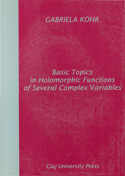| REZUMAT: |
In this book we give an elementary point of view of some classical topics in the
theory of holomorphic functions of several complex variables. There are some
phenomena which arise in higher dimensions and are of particular interest.
Among them we mention the following:
• The Riemann mapping theorem concerning the conformal equivalence
of simply connected domains in the complex plane does not hold in higher
dimensions.
• A domain Q in Cn, n > 2, is not necessarily a domain of holomorphy,
which means that Q need not be the maximal domain of definition for some
holomorphic function.
• The holomorphic functions of several complex variables cannot have iso-
lated singularities (any isolated singularity is removable).
The first chapter begins with an introduction to the theory of holomorphic
functions in higher dimensions. We present equivalent ways of defining holo-
morphic functions and we give basic properties of these functions such as the
Cauchy integral formula, the maximum principle, etc. We shall also present
the topological and metric structures of if(H,C), where Q is an open subset
of Cn, and we give a detailed proof of the well known result due to Hartogs
concerning the equivalence between separate holomorphy and (global) holo-
morphy. We also discuss an analogous result of Forelli concerning functions
which are holomorphic on complex lines through the origin. [...]
|
|
